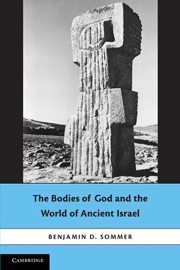Book contents
- Frontmatter
- Contents
- Preface
- Acknowledgments
- Introduction: God's Body and the Bible's Interpreters
- 1 Fluidity of Divine Embodiment and Selfhood: Mesopotamia and Canaan
- 2 The Fluidity Model in Ancient Israel
- 3 The Rejection of the Fluidity Model in Ancient Israel
- 4 God's Bodies and Sacred Space (1): Tent, Ark, and Temple
- 5 God's Bodies and Sacred Space (2): Difficult Beginnings
- 6 The Perception of Divinity in Biblical Tradition: Implications and Afterlife
- Appendix: Monotheism and Polytheism in Ancient Israel
- Notes
- List of Abbreviations
- Bibliography
- Scriptural Index
- Index of Rabbinic Citations
- Subject Index
Introduction: God's Body and the Bible's Interpreters
Published online by Cambridge University Press: 15 September 2009
- Frontmatter
- Contents
- Preface
- Acknowledgments
- Introduction: God's Body and the Bible's Interpreters
- 1 Fluidity of Divine Embodiment and Selfhood: Mesopotamia and Canaan
- 2 The Fluidity Model in Ancient Israel
- 3 The Rejection of the Fluidity Model in Ancient Israel
- 4 God's Bodies and Sacred Space (1): Tent, Ark, and Temple
- 5 God's Bodies and Sacred Space (2): Difficult Beginnings
- 6 The Perception of Divinity in Biblical Tradition: Implications and Afterlife
- Appendix: Monotheism and Polytheism in Ancient Israel
- Notes
- List of Abbreviations
- Bibliography
- Scriptural Index
- Index of Rabbinic Citations
- Subject Index
Summary
The god of the hebrew bible has a body. this must be stated at the outset, because so many people, including many scholars, assume otherwise. The evidence for this simple thesis is overwhelming, so much so that asserting the carnal nature of the biblical God should not occasion surprise. What I propose to show in this book is that the startling or bizarre idea in the Hebrew Bible is something else entirely: not that God has a body – that is the standard notion of ancient Israelite theology – but rather that God has many bodies located in sundry places in the world that God created.>
The bulk of this book is devoted to two tasks: first, demonstrating that in parts of the Hebrew Bible the one God has more than one body (and also, we shall see, more than one personality); and second, exploring the implications of this fact for a religion based on the Hebrew Bible. The first of these tasks is historical and descriptive in nature. The second, especially as taken up in the last chapter, is theological and much more speculative.
Before I embark on these two tasks, however, some readers may find a brief discussion of the corporeality of the biblical God beneficial. After all, Sunday school teachers and religious sages have long taught Jews and Christians that the Hebrew Bible is distinctive among the religious documents of antiquity precisely because it rejects the notion of a physical deity.
- Type
- Chapter
- Information
- The Bodies of God and the World of Ancient Israel , pp. 1 - 11Publisher: Cambridge University PressPrint publication year: 2009



